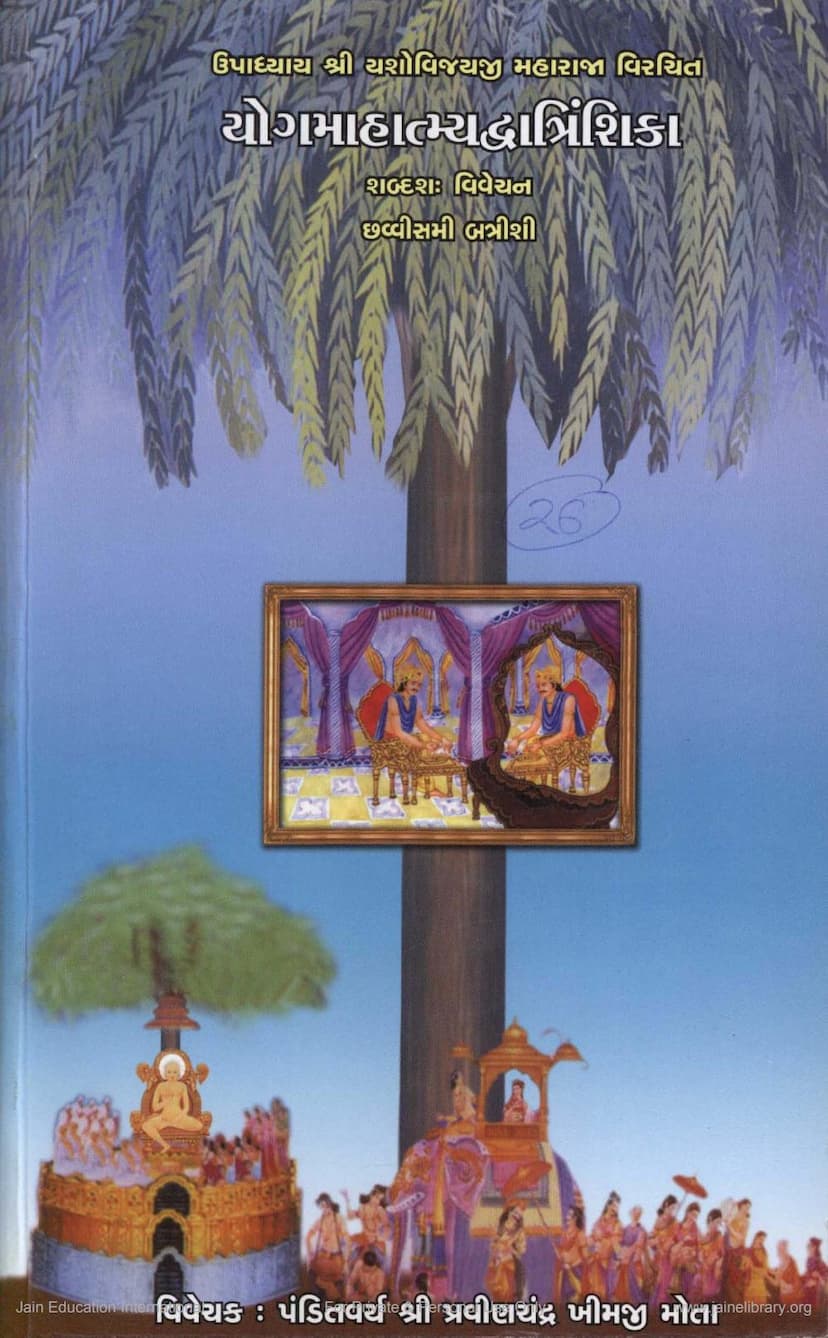Yogmahatmya Dvantrinshika
Added to library: September 2, 2025

Summary
This is a comprehensive summary of the provided Jain text, "Yogmahatmya Dvātrimśikā," based on the pages you've shared:
Book Title: Yogmahatmya Dvātrimśikā (Part of the larger Dvātrimśat Dvātrimśikā) Author: Mahāmahopādhyāya Upādhyāya Yaśovijaya Jī Mahārāja Commentator/Analyst: Paṇḍitavarya Śrī Pravīṇachandra Khīmjī Motā Publisher: Gitārtha Gaṅgā Catalog Link: https://jainqq.org/explore/004686/1
This text is the 26th Dvātrimśikā (a section of 32 chapters) within the larger work of Mahāmahopādhyāya Śrīmad Yaśovijaya Jī Mahārāja, titled "Dvātrimśat Dvātrimśikā." This specific Dvātrimśikā is titled "Yogmahatmya Dvātrimśikā," focusing on the Glory and Greatness of Yoga.
Core Subject and Purpose:
The primary goal of this text is to expound upon the profound significance and benefits of Yoga, as understood within the Jain philosophical framework. It aims to inspire individuals to pursue the path of Yoga for spiritual liberation and ultimate well-being.
Key Themes and Content:
-
The Essence of Scripture and Yoga: The text begins by asserting that Yoga is the essence and secret of all scriptures (upanishad), the path to liberation (moksha), the pacifier of suffering and afflictions (apāya-śamana), and the cause of ultimate welfare (kalyāṇa-kāraṇa). It stresses that mere scriptural study without the realization of Yoga is as futile as having a large family for the wealthy, which doesn't guarantee happiness without the right perspective.
-
The Fruits of Yoga (Yoga-kalpavriksha): The text likens Yoga to a wish-fulfilling celestial tree (yoga-kalpavriksha) whose fruits are manifold:
- In this life: Various miraculous powers (labdhi) are attained.
- In the next life: Great fortune, such as birth in noble families, auspicious circumstances, and self-mastery, is achieved.
- Ultimately: Freedom from the bondage of karma and attainment of spiritual liberation.
-
Yoga as a Means of Spiritual Transformation:
- Eradication of Afflictions (Klesha-nāśana): Following the 25th Dvātrimśikā, which identified Yoga as the remedy for afflictions, this section elaborates on Yoga's greatness.
- Purity and Liberation: Yoga is presented as the means to purify oneself from the defilements of karma and to attain the ultimate state of liberation (moksha).
-
Comparison and Integration with Patañjali's Yoga: A significant portion of the commentary delves into the concepts of Yoga presented by Patañjali's Yoga Sutras. The text discusses various yogic powers and attainments described by Patañjali, such as:
- Knowledge of past and future through concentration on transformations.
- Understanding the sounds of all beings through concentration on word, meaning, and intellect.
- Recollection of past lives through concentration on impressions.
- Knowledge of others' minds and their mental states.
- Powers related to controlling the body's energies and senses, such as levitation, invisibility, and mastery over elements.
- Attainment of divine sensory perceptions (divya śrotra).
- Knowledge of celestial realms, stars, and constellations.
- Understanding of the body's internal systems (nadis, chakras).
- Mastery over desires like hunger and thirst.
- Attainment of powers like anima, laghima, etc.
- The ultimate goal of liberation (Kaivalya) through the realization of the true nature of the self (Purusha) and its distinction from matter (Prakriti).
-
The Patañjali vs. Jain Perspective (Upapatti & Anupapatti): The commentary critically examines Patañjali's yogic siddhis (powers). While acknowledging their value, it often aligns them with Jain principles, explaining how certain powers are attained through the development of knowledge-obscuring karma (jñānāvaraṇīya) and energy-hindering karma (vīryantarāya) suppression. The text highlights that the ultimate goal of all yogic practices is the eradication of ignorance and attachment (moha-kṣaya) and the realization of the pure, unconditioned self, which is the core of Jain spiritual practice. The commentator, Yaśovijaya, emphasizes that the true culmination of saṁyama (concentration/control) is in its ultimate realization of the self (Ātman), as Patañjali himself acknowledges the self as the knower (jñātā) rather than solely the known (jñeya).
-
Yoga as a Means of Purification: Yoga is also presented as a penance (prāyaśchitta) for past negative karma. Even formidable karma can be eradicated by Yoga, just as fire burns even crooked trees.
-
The Power of Devotion and Recollection: The text highlights that even the mere recollection or contemplation of the word "Yoga" can act as a strong deterrent against the influx of negative karma, akin to an unbreakable barrier.
-
Distinction from Hatha Yoga: The text cautions against mere physical or external practices (Hatha Yoga) performed for worldly gains like livelihood or fame, stating that such practices are a mockery of Yoga (yoga-viḍambanā) and can lead to ruin. True Yoga aims at spiritual transformation.
-
The Greatness of Yoga's Desire: Even the desire or aspiration for Yoga is beneficial, being compared to the arrival of the monsoon season that alleviates the heat of worldly suffering, or a gentle breeze near a lake of great prosperity. It indicates a readiness for spiritual pursuit.
-
Yoga's Influence Beyond the Ordinary: The text even suggests that Yoga's influence extends to the divine (Parameśvara), implying that even enlightened beings benefit from the principles of Yoga, highlighting its supreme power.
-
Examples of Yogic Attainment: The text cites historical figures like Emperor Bharata (who achieved Kevala knowledge while ruling) and Marudevā Mātā (who attained the highest state of liberation despite not having practiced Yoga extensively in previous lives) as testaments to the transformative power of Yoga.
-
Commentary and Structure: The book presents a detailed, word-by-word analysis (śabdaśaḥ vivēcana) of the original text by Yaśovijaya Jī, with the commentary by Praveenchandra K. Mota. The introduction explains that the "Yogmahatmya Dvātrimśikā" is the 26th chapter within the larger "Dvātrimśat Dvātrimśikā," which comprises 32 sections, each with 32 verses, dealing with various philosophical and yogic topics.
In essence, "Yogmahatmya Dvātrimśikā" is a profound Jain treatise that glorifies Yoga as the ultimate path to liberation, detailing its various powers, its capacity for spiritual purification, and its integration with yogic practices described in classical traditions, all viewed through the lens of Jain philosophy. It serves as a guide and inspiration for seekers on the spiritual path.